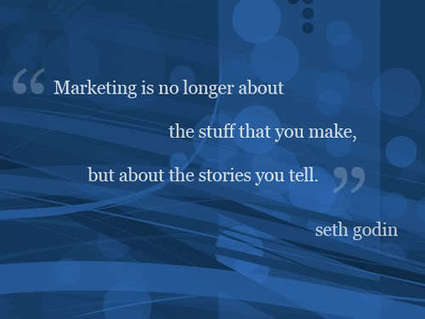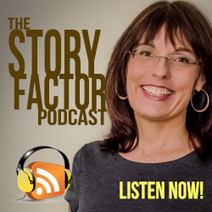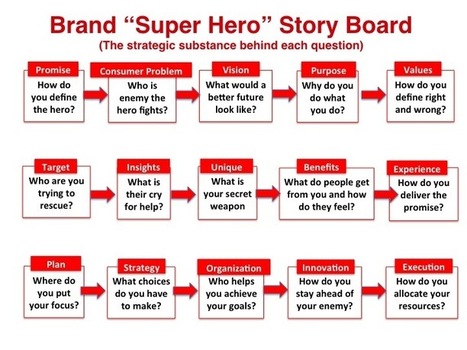 Your new post is loading...
 Your new post is loading...
"The 2015 Content Marketing Institute Survey clearly highlights the pain of not having a documented strategy to deliver effective storytelling. Regardless of B2B or B2C, we marketer’s are on the hook to put strategy into our content marketing.
But what does a content strategy look like? How does it relate to a marketing strategy? How do you know you have it?"
Read the full article to find out more about this summary of what business storytelling strategy looks like: - When done right you see the same person, purpose, and program in every piece of content.
- The different pieces of content are complimenting each other, telling the same story.
"“The State of Storytelling” is a project that came to life out of an interest to know how the nonprofit sector is actually using stories and what results organizations are getting. Stories are constantly talked about as a tactic, but are they really helping nonprofits get better fundraising results?
Together, Network for Good and I teamed up to survey more than 400 nonprofits about storytelling."
Read the full article to download the findings of this research. You'll find out more about: - The top three most popular channels for storytelling
- Emerging trends
- Recommendations to help your organization
- Measuring the impact of stories
- Testing stories
- Creating a culture of storytelling
- Creating a storytelling strategy
- Examples of great storytelling
"Have you wondered how to shoot a hospital video story that moves your audience to tears? Or how to write a CEO speech that will earn a standing ovation?
Nasdaq Corporate Solutions and Ragan Communications are offering a free guide—Strategic Storytelling—full of tips for telling your organization's story though a wide range channels, from newsletters to videos."
Read the full article to obtain the link to this free guide featuring advice and case studies from corporations such as Intel, Fiat Chrysler Automobiles and American Express Open Forum. This 24 page guide covers: - The three elements of a story
- How to find stories within your company
- Starting your story: the anecdotal lede
- How to bring your story to life with video
- How to write memorable speeches & intriguing op-eds
- How to write compelling press releases
- Storytelling using brand journalism
- How to get emotional with images
- How to educate and entertain with infographics
"When reorienting a brand and clarifying their core reason for being, companies are too often satisfied with a shallow exploration, settling on empty cliches when they should be seeking the real concept they’re sincere about and deeply committed to.
The Slippery Part of Finding the Untold Story. It’s because it’s so obvious to “everyone.”
But when you dig a bit deeper, you discover the “everyone” is made up of all those inside the company, those who breathe this stuff everyday. But those outside the company may never have heard your story.
In other words, since it’s SO obvious to you, you no longer notice or talk about some of those subtleties that make you different. You take them for granted. You simply forget how different your company is compared to all the other choices your audience has."
Read the full article to find out more about: - the 3-step formula for fully defining a company’s untold story and unearth the human component
- the case study of how a dance school, 29 years in business, rebranded and revitalized themselves by finding their untold stories
"Take two minutes to watch this advert from IKEA. Those two minutes are guaranteed to change how you think about marketing your business. This video is more than just advertising designed to sell something, it’s a home run in brand storytelling."
Read the full article to find out more about these 10 things that Ikea did to make their story great:
- Understood their customer’s worldview.
- Made the customer the hero.
- Started with his story.
- Changed how the customer felt and acted in the presence of their product.
- Understood what they are really selling.
- Helped us to see reflections of ourselves in the hero.
- Tapped into our emotions, creating a visceral connection with the brand.
- Created advertising that aligns with the company’s vision and brand personality.
- Backed up the story with the experience delivered in store and across all touchpoints with the brand.
- Gave potential customers something to believe in.
Stories and brands have a lot in common. Watch the slideshare to find out more about the comparisons, how successful brands use stories, how social media is moving both forward, and: - The basics of storytelling
- Triple-A stories
- From storytelling to storyselling
- Cases
- About Brandhome
- Take-aways
Via Thorsten Strauss, Pantelis Chiotellis
Concerned that you don't have enough drama or action in your company story? Don't worry. You can craft a company story that is both compelling and informative.
Read the full article to find out more about these five essential ingredients to tell a compelling company story: - Inspiration
- Challenges
- Claims to fame
- Accomplishments
- Vision
"Businesses are struggling to craft authentic and compelling stories and content to engage consumers online and inspire them to act.
So how do you shape a story that will move consumers, without coming across as cheesy? I asked Maria Sipka, CEO of Linqia, a tech company matching social storytellers to brand marketers, to share her tips."
Read the full article to find out more about how to implement these 3 steps to a compelling story: - Find them in their context-and serve up stories there
- Be authentic-be a trusted person not trying to sell anything
- Track accountability and ROI-close the loop
"Want to grow your business? Then share your customer stories. Yet one of the greatest difficulties entrepreneurs, nonprofits, and large corporations have is collecting their customer stories."
Read the full article to find a curated collection of articles, by fellow Scoop.iter Karen Dietz, that touch on these topics that will help you find and tell your customers stories: - who the real hero of the story is
- how to gather stories
- how to listen for customer stories
- how to turn your customer stories into repurpose-able content
When should you use real names in business storytelling? And when should you change the names to protect the innocent (and yourself)?
Characters are an essential ingredient of a story. Read the full article to find out more about these three tips on using names in business storytelling: - If it’s a positive story, use real names
- If it’s sensitive, change the names but keep the character
- Negative stories – take care
Create a powerful brand story that grabs prospects’ attention like a great movie with these 15 brand storytelling techniques.
Read the full article to find out more about: - Take the time to prepare
- Learn how to tell a good story
- Focus on the active struggle
- Skip the slow parts
- Match your brand story to the format
- Control your pacing
- Make it personal
- Focus on the human element
- Make the stakes clear
- Follow a classic story pattern
- Throw in a surprise
- Make sure you have a solid beginning, middle, and end
- Avoid “moral of the story” endings
- Use natural language
- Make the story visual
"We kicked off The Storytelling Non-Profit Virtual Conference this morning and what a way to get the week started! Over 400 people attended the two sessions this morning to learn about the basics of storytelling and how to work better with your Board on fundraising."
This Virtual Conference ran between January 27-31. Read the full article to see the SlideShare deck as well as the notes from the first session, and access the following links to see the remaining session notes:
Annette Simmons, business storytelling author and thought leader in the field, interviews Karen Dietz about her insights into business storytelling.
Karen talks about the importance of story sharing instead of storytelling, why she prefers not to do single story workshops with clients, and what to pay attention to when working with stories in organizations.
Read the full article to find out more details about what you'll find out by listening to this free podcast.
|
"I am optimistic about the next phase of storytelling bringing the industry to a better place—although I do have a bone to pick with how some organizations knowingly (or unwittingly) get in their own way."
Read the full article to find out more about these five things companies do that can impede storytelling success: - The Complexity Conundrum
- The Superhuman Fallacy
- Fear of Risk
- The Perfect Ending
- Hiding Behind a Corporate Veil
"We are hard wired for stories but I don’t think we recognize what a huge reservoir of insights, lessons learned and experiences we have to share with others.
The intent of a story. Storytellers are, by nature, collaborative and giving and can have three major choices in terms of the intent of telling their story: to inform, to inspire or to provoke.
I believe leaders in organizations need to employ the use of stories more in their communications. The question is how do you do that? How do you construct a good story you can use as a key resource in your bag of leadership tools?"
Read the full article to find out more about these 4 key steps to constructing a great business story: - Make a list of people
- Make a list of settings
- Write down problems or challenges
- Write down lessons learned
"While there are great ways to find those customer stories, the easiest (or laziest) seems to be launching a campaign that invites customers to share theirs, like the Arizona Families for Home Education did (at left). So routine has the “tell us your story” campaign become that there’s now a Tumblr blog dedicated to the concept. Tell Us Your Story collects campaigns shared by readers who can submit images, in addition to those ad copywriter Brian Eden finds on his own. Eden is behind the Tumblr blog, which he created after seeing “Tell us your story at drpeppertuition.com” on a Dr. Pepper can he was drinking.
Customer stories are, indeed, important, given they’re more credible than advertising or messaging from your CEO or paid spokespeople. But there are better ways—not necessarily easier, but better—for obtaining customer stories. Just watch some of the testimonial videos from The Mayo Clinic. What you see is heart-felt, authentic, and sincere, not the result of a call to action. How does The Mayo Clinic get these stories? In many cases, they’re shared with the communications team by staff with direct knowledge of the patients’ experience."
Read the full article to find out more about these other sources of customer stories that don’t require you to pimp for them: - Read the messages people send to customer service
- Use your monitoring service
- Ask your employees
- Reach out to your brand ambassadors
- Survey your customers
- Get your biggest fans in the same room
"In the past, everything about case studies has probably made you run far away. They are often dry, generic, or pretty much just a high school pep rally (minus the cool letterman jackets) cheering on a company, product, or solution. But they don't have to be.
Good case studies can help to subtly yet persuasively show off products or services. They tell the story of a business problem that your customer had and what you did to help overcome it. Statistics offer tangibility, and quotes from the customer give credibility."
It's time to take a different approach to writing case studies so that they're read and shared—and result in more leads. Read the full article to find out more about these five things you should keep in mind to create case studies that are less boring and more effective: - Build suspense
- What's in it for them?
- Testimonials are everything
- Make it visual
- Don't lie
By ascribing a story to your company, you provide an illustrated example of how, why and what you do, while assigning an emotional weight to your company’s journey. The result is the creation of a brand. How can you harness that emotional response to better communicate your company’s mission and overall goals? Let’s examine some of the tenets of storytelling for business and how they can be applied to your organization."
Read the full article to find out more about these elements of a brand story and where companies can typically find them: - Inciting incident
- Rising action
- Turning point (climax)
- Falling action
- Denouement
Presentation given to University of Chicago Alums re: Story Theory and its Application To Marketing. How to use the same traditional storytelling structure for a brand story.
"A little daunted at the thought of writing your own brand story, one that you can actually become? While it does take some time and thought, creating a story for your graphic design business is very doable if you follow some story-telling tips and are honest with yourself."
Read the full article to find out more about this advice and examples, and you’ll have an excellent starting point for pulling your own real story together into a brand that sticks with clients: - create your character
- create the plot
- start off with a hook
- don't forget the conflict
- include a call to action
- create a realistic voice
- make it visual
- add interactive elements
- create the right pace
Via José Carlos
"The Brand story should distill everything you know about your brand (the vision, purpose, values, objectives, strategies, tactics, target market, insights, rational and emotional benefits, reason to believe) and organize it into something that is digest-able for everyone who might touch the brand–whether that’s consumers, advocates, influencers, employees, agencies, retailers or the media."
To help you find your brand story, read the full article to find out more about these tips on using the basis of the Super Hero story usually starts with a conflict of Good versus Evil: - There is a substantial back story to explain what makes up the Super Hero.
- A good Super Hero story saves someone. A good brand should as well. Each story also has a distinct cry for help.
- A Super Hero is different than everyone else.
- There is some super power that makes them even better, without being vain.
- A good story is one that touches people in an emotional way.
- A Good Super Hero has to make difficult choices. They can’t do everything. It’s all about choices.
- A good story is well-organized, has a consistent tone throughout the story and has layers that support the story.
- No Super Hero goes alone. They always have help.
And find the story board format with the 15 questions that you can use to frame your story.
"There is no shortage of stories and anecdotes to illustrate how the best strategies can nearly always be reduced down to a brief but powerful statement and even more ink has been spilled describing the dangers of strategy statements that read like detailed action plans.
But how do you go about actually crafting — and using — a 15-word strategy statement?"
Read the full article to find out more about the authors approach by getting clients to write a story based on a brief template starting with "Once upon a time there was..." And then see what a swimsuit company was able to do with it.
"By combining colorful characters with an interesting angle, marketers can create a compelling story to attract their audience."
Read the full article to find out more and see examples about these ideas for your next marketing story: - Use customer success stories or testimonials
- Tell a picture story
- Ask your audience to share their stories
- Attend a conference, event or show and write about it
- Discuss data
- Tell the “rags to riches” story
Brand Storytelling - 4 Part Series | GoAnimate
"Forging a sincere connection with the customers is one of the greatest challenges any company can face. People don’t connect with entities that are perceived as out-of-touch, bland, too slick or gimmicky, or too sales-focused. They connect with personalities: the individuals and aspirations behind your company. The best way to cultivate that connection — to interest them in what you do — is to give them the who and how and why behind the what. Make your business personal in the best possible way: tell your story."
Click on the links below to read this four part series from GoAnimate to find out more about how to tell your brand story.
Part 1: Fun And Profit Brand storytelling is a proven method for relating to your customers on a more personal level. Stories help personalize your brand, build connections, and inspire trust. - People connect with story
- People trust story
- Story builds brand
Part 2: Find Your Brand Values People buy your story, not your product. So when you tell someone your story, where do you begin? Find your values, find your story. For most businesses, your values will fall into one of three categories: - Higher values
- Aspirational life values
- Day-to-day values
Part 3: Different Stories For Different Purposes How have successful companies wrapped these values in a story that made them accessible and engaging to their customer bases? We’ve identified three recurring story types used by effective brand storytellers. - Your origin story
- Your vision story
- Your customer's story
- Mix 'n' match
Part 4: Telling The Whole Story What you say about your company plays an important role in how people see you, but what you do rounds out the picture. If the two don’t match, it won’t matter how good your marketing messaging is. Remember: everything your business does becomes a part of your brand story. - Living your values
- Beyond the About page: Where to tell your story
- Control your story
"Use storytelling to influence people and move them to action Need to get your point across? Get staff on board with change? Foster collaboration? Increase sales? Strengthen employee engagement? Build customer loyalty? Drive innovation and creativity? Capture best practices? Align people around a goal? Grow your business? Business Storytelling For Dummies can help you do this—and more."
Hot off the press. Written by Karen Dietz and Lori Silverman. Put it on the top of your Christmas wishlist.
|



 Your new post is loading...
Your new post is loading...



![[Resource] The State of Storytelling | The Storytelling Non-Profit | How to find and tell your story | Scoop.it](https://img.scoop.it/l8Vo_61xhDNOmPBSOG66Ujl72eJkfbmt4t8yenImKBVvK0kTmF0xjctABnaLJIm9)




![The Five Essential Elements of a Great Company Story [Infographic] | MarketingProfs | How to find and tell your story | Scoop.it](https://img.scoop.it/mZz17xjbRSkT1VdFp1NerDl72eJkfbmt4t8yenImKBVvK0kTmF0xjctABnaLJIm9)
































